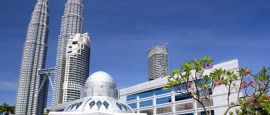Malaysia Weather, climate and geography
Weather & climate
Malaysia has a tropical climate, characterised by warm temperatures, high humidity, and abundant rainfall throughout the year. Temperatures typically range between 25°C and 32°C (77°F to 90°F), with little variation throughout the year. However, weather patterns differ slightly between West Malaysia (Peninsular Malaysia) and East Malaysia (Sabah and Sarawak) due to geographical differences.
West Malaysia (Peninsular Malaysia)
West Malaysia experiences distinct weather differences between its east and west coasts during the monsoon seasons. The southwest monsoon (April to October) brings wet weather to the west coast (e.g., Penang, Melaka, Langkawi), although the showers are often short and manageable for city visits.
In contrast, the northeast monsoon (November to March) affects the east coast (e.g., Terengganu, Redang, and Tioman), bringing heavy rainfall and rough seas. During the northeast monsoon, many east-coast islands are closed to tourists, and ferry services are suspended.
East Malaysia (Sabah and Sarawak)
East Malaysia on the island of Borneo experiences heavy rainfall during the northeast monsoon (November to March), especially in coastal areas like Kota Kinabalu and Kuching. Rainfall here is more evenly distributed throughout the year compared to West Malaysia. Inland and highland areas, such as Mount Kinabalu, enjoy slightly cooler and less humid weather.
A quick overview of the monsoon seasons
Southwest Monsoon (April to October): Brings heavy rain to the west coast of Peninsular Malaysia, including Penang, Langkawi, and Malaka.
Northeast Monsoon (November to March): Primarily affects the east coast of Peninsular Malaysia and East Malaysia, causing widespread rainfall and rough sea conditions.
Best Time to Visit
West Malaysia: The dry season on the east coast (April to October) is ideal for visiting islands like Redang, Perhentian, and Tioman. Conversely, the west coast is pleasant from November to March, with relatively drier conditions in Penang and Melaka.
East Malaysia: For both Sabah and Sarawak, the dry season (April to October) is the most comfortable and convenient for travellers, as the weather is drier and outdoor activities are more accessible. However, if you're interested in lush greenery and fewer tourists, the rainy season can also have its charm, provided you're prepared for wet conditions.
Malaysia's tropical climate calls for lightweight, breathable clothing made from materials like cotton or linen. Casual attire is suitable for most places, but visitors should dress modestly in rural areas and states with larger Muslim populations, such as Kelantan and Terengganu. When visiting religious sites like mosques or temples, both men and women should cover their shoulders and knees, and women should also wear a headscarf in mosques. Comfortable walking shoes and a light rain jacket or umbrella are also recommended, as sudden tropical showers are common.
Do you have any Feedback about this page?
© Columbus Travel Media Ltd. All rights reserved. No part of this site may be reproduced without our written permission, click here for information on Columbus Content Solutions.
¿Tiene comentarios sobre esta página?
© Columbus Travel Media Ltd. All rights reserved. Ninguno de los contenidos de esta Web debe ser reproducido sin nuestra autorización expresa y escrita. Para más información sobre como obtener permiso para la utilización del contenido clica aquí. No part of this site may be reproduced without our written permission, click here for information on Columbus Content Solutions .
Avez-vous des commentairessur cette page?
© Columbus Travel Media Ltd. All rights reserved. Le contenu de ce site ne peut être reproduit sans autorisation écrite. Cliquez ici pour plus d'information sur notre 'des solutions de contenu’. No part of this site may be reproduced without our written permission, click here for information on Columbus Content Solutions.
Haben Sie Feedback zu dieser Seite?
© Columbus Travel Media Ltd. All rights reserved. Alle Inhalte dieser Seite sind urheberrechtlich geschützt und dürfen nur mit schriftlicher Genehmigung des Verlags genutzt werden. Weitere Informationen finden Sie in unseren Lizenzbestimmungen. No part of this site may be reproduced without our written permission, click here for information on Columbus Content Solutions .





 You know where
You know where
